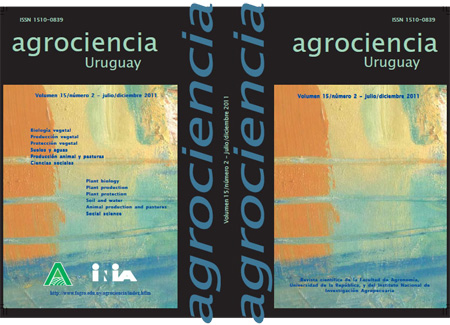Ver ítem
- xmlui.general.dspace_homeCentros Regionales y EEAsCentro Regional Buenos Aires SurEEA BalcarceArtículos científicosxmlui.ArtifactBrowser.ItemViewer.trail
- Inicio
- Centros Regionales y EEAs
- Centro Regional Buenos Aires Sur
- EEA Balcarce
- Artículos científicos
- Ver ítem
Efectos de Carbaryl y Metaldehído sobre Armadillidium vulgare (Crustacea: Isopoda) y Milax gagates (Mollusca: Pulmonata) en soja bajo siembra directa
Resumen
Los objetivos fueron evaluar la eficacia de control y las dosis de los cebos Metaldehído 4% + Carbaryl 8% (2, 4 y 6 kg ha-1),
Carbaryl 8 %, y Metaldehído 4 % y 5 % (2 y 4 kg ha-1) sobre Armadillidium vulgare y Milax gagates y determinar el número
de plantas y rendimiento en soja. El diseño fue en bloques completos aleatorizados con tres repeticiones. Se evaluó el número
de A. vulgare y M. gagates vivos a los 3, 7, 10 y 16 días después de la aplicación
[ver mas...]
Los objetivos fueron evaluar la eficacia de control y las dosis de los cebos Metaldehído 4% + Carbaryl 8% (2, 4 y 6 kg ha-1),
Carbaryl 8 %, y Metaldehído 4 % y 5 % (2 y 4 kg ha-1) sobre Armadillidium vulgare y Milax gagates y determinar el número
de plantas y rendimiento en soja. El diseño fue en bloques completos aleatorizados con tres repeticiones. Se evaluó el número
de A. vulgare y M. gagates vivos a los 3, 7, 10 y 16 días después de la aplicación de los cebos (DDA), número de plantas
m-2 y rendimiento (kg ha-1). El número de A. vulgare fue menor con Metaldehído 4 % + Carbaryl 8 % y con los cebos con
Carbaryl 8 % respecto al testigo a los 3, 7, 10 y 16 DDA (χ2 ptrat < 0,05). A los 3 DDA, el número de M. gagates disminuyó con
Metaldehído 4 % + Carbaryl 8 % y Metaldehído 4 % y 5 % en relación al testigo (χ2 ptrat = 0,0806). El número de plantas
m-2 difirió entre los tratamientos (χ2 ptrat = 0,0003), y se obtuvo un número mayor con la aplicación de los cebos que con el
testigo. En el rendimiento se detectó efecto de los tratamientos (χ2 ptrat = 0,0188), sin embargo sólo la dosis de 2 kg ha-1 de
Carbaryl 8 % fue diferente del testigo. Se concluye que la eficacia de control del cebo Metaldehído + Carbaryl resultó
semejante a la obtenida con los crustacicidas formulados con Carbaryl sobre A. vulgare y a los molusquicidas con Metaldehído
sobre M. gagates. La aplicación de los cebos aumentó el número de plantas.
[Cerrar]
The aim was to evaluate the control efficacy and dose of Metaldehyde 4 % + Carbaryl 8 % (2, 4 y 6 kg ha-1), Carbaryl 8 %, and Metaldehyde 4 % y 5 % (2 y 4 kg ha-1) baits on Armadillidium vulgare and Milax gagates, and to determine the number of plants and yield in soybean. The design was a randomized complete block with three replications. We evaluated the number of A. vulgare and M. gagates alive 3, 7, 10 and 16 days after application of bait (DAA),
[ver mas...]
The aim was to evaluate the control efficacy and dose of Metaldehyde 4 % + Carbaryl 8 % (2, 4 y 6 kg ha-1), Carbaryl 8 %, and Metaldehyde 4 % y 5 % (2 y 4 kg ha-1) baits on Armadillidium vulgare and Milax gagates, and to determine the number of plants and yield in soybean. The design was a randomized complete block with three replications. We evaluated the number of A. vulgare and M. gagates alive 3, 7, 10 and 16 days after application of bait (DAA), number of plants m-2, and yield (kg ha-1). The
number of A. vulgare was lower with Metaldehyde 4 % + Carbaryl 8 % and with baits based on Carbaryl 8 % compared to the control at 3, 7, 10 and 16 DAA (χ2 ptrat <0.05). At 3 DDA, the number of M. gagates decreased with Metaldehyde 4 % + Carbaryl 8 % and with the molluscicides in relation to the control (χ2 ptrat =0.0806). The number of plants m-2 differed between treatments
(χ2 ptrat = 0.0003), and a higher number was obtained with the baits application than with the control. Yield showed the effect of treatments (χ2 ptrat = 0.0188), however, only the 2 kg ha-1 Carbaryl 8 % dose was different from the control. It was concluded that the
control efficacy of Metaldehyde+Carbaryl baits was similar to the one obtained by crustacicides formulated with Carbaryl on A. vulgare, and to molluscicides with Metaldehyde on M. gagates. Applying baits increased the number of plants.
[Cerrar]

Autor
Fuente
Agrociencia Uruguay 18 (2), 82-89. (Julio/diciembre 2014)
Fecha
2014
ISSN
2301-1548
Documentos Relacionados
Formato
pdf
Tipo de documento
artículo
Proyectos
(ver más)
INTA/PNNAT/1128043/AR./Los agroquímicos como fuente de contaminación difusa en agroecosistemas.
Palabras Claves
Derechos de acceso
Abierto
 Excepto donde se diga explicitamente, este item se publica bajo la siguiente descripción: Creative Commons Attribution-NonCommercial-ShareAlike 2.5 Unported (CC BY-NC-SA 2.5)
Excepto donde se diga explicitamente, este item se publica bajo la siguiente descripción: Creative Commons Attribution-NonCommercial-ShareAlike 2.5 Unported (CC BY-NC-SA 2.5)


